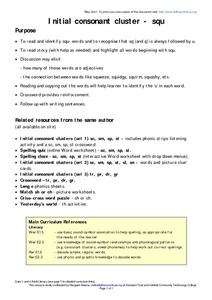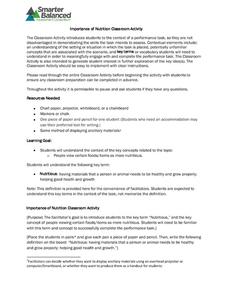Curated OER
What's in a Name?
Students study the binomial system of naming organisms. They are given a name of an organism and they must draw a picture of what they think the organism looks like. Then they research the organism, find what it really looks like, and...
Curated OER
Classification and Identification
Young scholars, after exploring and analyzing diagrammatic and taxonomic keys and their association to marine sciences, identify and classify objects and organisms based on visual attributes/characteristics. They research and create...
Curated OER
The Article II
In this grammar worksheet, students practice using expressions of quantity in a variety of assignments associated with thirty-six sentences.
Curated OER
Symmetry and Symbols
Students identify symmetrical and congruent elements in folk art. In this art and geometry instructional activity, students examine pictures of Masonic Plaque in the Form of a Royal Arch Tracing Board for evidence of congruent and...
Curated OER
Introduction to Sea Horses
Learners identify different types of sea horses. In this sea horse research lesson, students learn associated vocabulary and listen as the teacher reads Elaine Landau's, Sea Horses A True Book. They visit assigned Internet sites to find...
Curated OER
Idioms
Students, who are not native English speakers, determine how idioms are used in speaking and writing. For this idiom lesson, students listen to tapes of non-native speakers, and work on vocabulary exercises aimed at increasing their use...
Curated OER
Jean Hasbrouck House
Students research lifestyles from the 18th century. They examine artifacts from the Jean Hasbrouck House and associate them with the responsibilities and roles of the people who lived there. They make candles and consider the importance...
Curated OER
Vocabulary in the Content Area
Young scholars make connections between new vocabulary words and what they already know by illustrating the words and writing about them.
Curated OER
Onomatopoeia
This mini-lesson plan on onomatopoeia introduces the device through a poem and definition. It culminates in drawing an element of nature with the sound associated with it written across the picture.
Curated OER
Counting to 5
Tiny scholars count 5 lollipops by ones, filling in the blank in a sentence with the total amount. Have them color in the pictures to develop fine motor skills for writing. Useful notes for teacher about developing 1:1 correspondence and...
Curated OER
The Me Book
Learners relate to the pictures as symbols so that they come to point to named pictures, explain what pictured objects are for, match pictures to real objects, categorize objects, and recognize words.
Curated OER
Count to 5
A cute illustrated kitten instructs pupils to color 5 of 10 paintbrushes pictured. Then they write the number 5 to complete the sentence frame, "I have coloured ___ paint brushes." The English spelling of "colour" is used.
Curated OER
Beginning Sounds Worksheet
In this early childhood beginning sounds worksheet, students recognize beginning letters of words as they look at the pictures of the newspaper, money, octopus, jellyfish, duck and yarn on the page and choose from the letters in a box...
Curated OER
Initial Consonant Cluster
In this grammar activity, students read and identify squ- words and then, recognize that sq (and q) are always followed by u. They also read a story and highlight all the words that begin with squ. Finally, students complete a crossword...
Curated OER
What Goes With Blocks?
In this associations worksheet, students choose the correct word and picture that goes with blocks. Students decide between the words doll, house, clean, and jump.
Curated OER
What Goes With Cereal?
In this grouping worksheet, students choose the correct word and picture that goes with a cereal. Students decide between the words toast, ball, family, and chair.
Curated OER
What Goes With Circle?
In this grouping worksheet, students choose the correct word and picture that goes with a circle. Students decide between the words cat, girl, my, and triangle.
For the Teachers
Story Strips Sequencing
What happens next? Work on story sequence with a lesson that prompts kids to put a story back in order. Additionally, they discuss what would happen if one event was missing from the sequence.
Anthropological Association
Race: Teacher Guide: Race
How has the concept of race changed over time? Explore the genetic, cultural, and social aspects of race through a series of impactful activities. Scholars discover how race is influenced by inherited traits, examine census records to...
Texas Education Agency (TEA)
Byzantine Architecture
View Byzantine architecture from the comfort of your classroom. A PowerPoint presentation introduces important vocabulary terms and examples of Byzantine architecture in the ninth lesson plan of the 11-part series. A Jeopardy game...
University of the Desert
How Do I Feel That My Culture Is Misunderstood by Others?
Using video clips of young adults from around the world describing their cultures and how they can be misunderstood, learners compare their own cultural point of view to that of others through discussion and writing.
Museum of Disability
Ian’s Walk and Apples for Cheyenne
Help young learners understand friendship and empathy with two reading comprehension lessons. Each lesson focuses on a story about a child with autism, and encourages readers to compare and contrast the characters to each other and to...
Curated OER
The True Confessions of Charlotte Doyle: Graphic Organizer
After completing the first five chapters of The True Confessions of Charlotte Doyle By Avi, use direct quotes to make inferences about how Charlotte feels about certain characters. Later, when the novel has concluded, revisit the text to...
Smarter Balanced
Importance of Nutrition
Prepare your class members for the performance task assessment on nutrition with an activity that asks class members to rank images of foods from least nutritious to most. Participants also offer reasons for why they ranked the foods the...

























